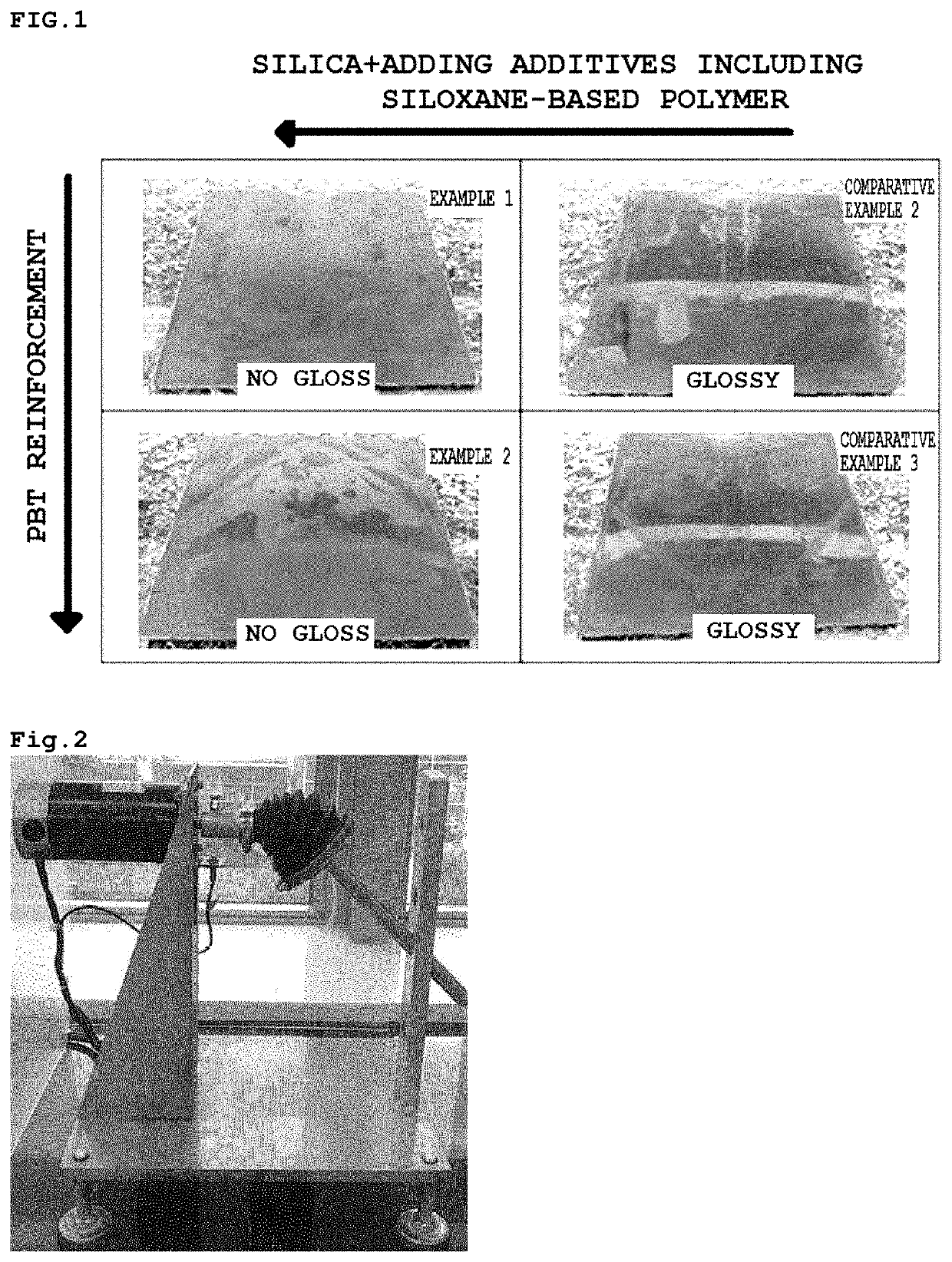Thermoplastic copolymer composition and molded article manufactured using the same
a technology of thermoplastic copolymer and molded article, which is applied in the field of thermoplastic copolymer composition, can solve the problems of noise generation of 90 db or more, noise caused by friction between the surfaces of corrugated boots, and noise generation of friction between the surfaces of corrugated boots, and achieve excellent compatibility with elastomers, reduce noise generation, and strengthen the soft properties of molded articles
- Summary
- Abstract
- Description
- Claims
- Application Information
AI Technical Summary
Benefits of technology
Problems solved by technology
Method used
Image
Examples
experimental example 1
[0078]The physical properties of thermoplastic copolymer composition specimens manufactured in Examples 1 to 4 and Comparative Examples 1 to 7 were measured according to the following methods, and the results are shown in Tables 1 and 2 below.
[0079]1) Melt index (g / 10 min): The melt index of the specimen was measured according to the ISO 1133 test standard (under the conditions of 230° C. and 10 kg).
[0080]2) Hardness (Shore D): The Shore D hardness of the specimen was measured according to the ISO 868 test standard.
[0081]3) Tensile strength (MPa) and tensile elongation (%): The tensile strength (MPa) and tensile elongation (%) of the specimen were measured according to the ISO 527-2-5A test standard.
[0082]4) Number of noise generation cycles: The number of cycles at which a noise of 75 dB or more was generated was measured for a molded article.
TABLE 1ExamplesClassification1234CompositionThermoplastic100100100100(Unit:polyesterparts byelastomer (TPEE)weight)Polytetramethylene5554glyc...
experimental example 2
[0086]FIG. 1 shows the surface conditions of specimens manufactured according to Examples 1 and 2 and Comparative Examples 2 and 3, in which PTMG was used in the same amount in a thermoplastic copolymer composition, after leaving the specimens for 1 week.
[0087]As shown in FIG. 1, under the condition of using the same amount of PTMG, in the case of Example 1 in which the additives including silica and the siloxane-based polymer were added and in the case of Example 2 in which PBT was additionally added, no gloss was observed on the surfaces of the specimens. On the other hand, in the case of Comparative Examples 2 and 3 in which silica and the siloxane-based polymer were not added, gloss was observed on the surfaces of the specimens. These results indicate that silica and the siloxane-based polymer used in Examples 1 and 2 increased the exudation rate of PTMG to the extent that the surface gloss of the specimen disappeared. In addition, these results suggested that, when the phenomen...
experimental example 3
[0088]The coefficient of friction and the gloss of thermoplastic copolymer composition specimens manufactured in Example 2 and Comparative Example 3 were measured using the following methods, and the results are shown in Table 3 below.
[0089]5) Coefficient of friction: The coefficient of friction was measured while moving a ball tip with a weight of 10 kg on a 100×100×2 mm square specimen by 30 mm.
[0090]6) Gloss: Gloss was measured at a reflection angle of 60° using a glossmeter (TC-108DPA, Tokyo Denshoku Co.).
TABLE 3ComparativeClassificationExample 2Example 3Coefficient of friction0.0350.064GlossImmediately after2524.2injectionAfter leaving at room0.815temperature for 1 weekReduction rate (%)96.838
[0091]Referring to Table 3, compared to Comparative Example 3 not including the additives, the thermoplastic copolymer composition (Example 2) including the additives according to the present invention had a very small coefficient of friction, indicating that friction noise resistance was ...
PUM
| Property | Measurement | Unit |
|---|---|---|
| melt index | aaaaa | aaaaa |
| reflection angle | aaaaa | aaaaa |
| bending angle | aaaaa | aaaaa |
Abstract
Description
Claims
Application Information
 Login to View More
Login to View More - R&D
- Intellectual Property
- Life Sciences
- Materials
- Tech Scout
- Unparalleled Data Quality
- Higher Quality Content
- 60% Fewer Hallucinations
Browse by: Latest US Patents, China's latest patents, Technical Efficacy Thesaurus, Application Domain, Technology Topic, Popular Technical Reports.
© 2025 PatSnap. All rights reserved.Legal|Privacy policy|Modern Slavery Act Transparency Statement|Sitemap|About US| Contact US: help@patsnap.com



